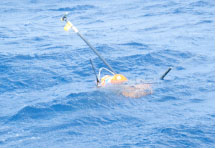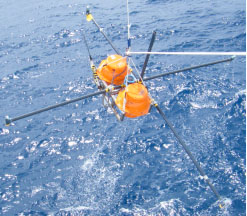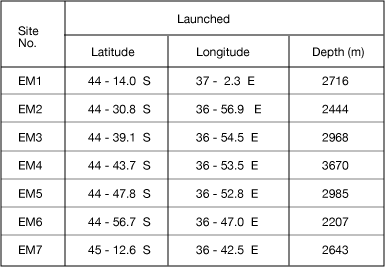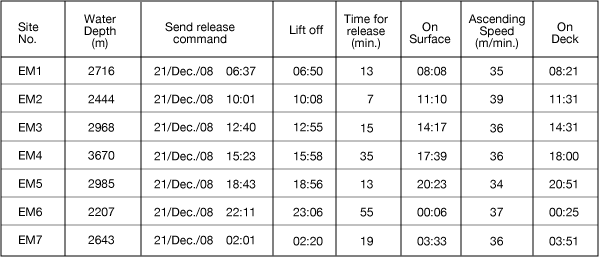Recovery of OBEM (Ocean Bottom Electro-Magnetometer)
during the 27th Umitaka-maru Cruise
1/December/2008 - 2/January /2009
From Benoa to Cape Town
Scientists on land
![]() Kyoko Okino, Ocean Research Institute, The University of Tokyo
Kyoko Okino, Ocean Research Institute, The University of Tokyo
![]() Yoshifumi Nogi, National Institute of Polar Research
Yoshifumi Nogi, National Institute of Polar Research
Summary
We conducted marine magnetotelluric transect using OBEM (Photo 1) for imaging upper mantle structure across the Southwest Indian Ridge 37°E. The Marion hotspot locates in the south of the spreading center and could interact with the spreading system. We successfully recovered all of 7 OBEMs at 7 sites (Table 1 and Figure 1), which had been deployed during the KH07-4 Hakuho-maru cruise in January 2008. Sites spacing was approximately 10 km in the vicinity of the spreading center, but the spacing was coarser at the both ends (30km). The recovery of the OBEM was made on 21-22 December 2009, and its timetable is given in Table 2. The observations were made from 19 January 2008 up to the recovery. The OBEM measured geomagnetic and electric field variation, and these data will address issues of the nature and distribution of melting beneath the spreading system through estimation of the electrical conductivity structure of the upper mantle. Furthermore, the upper mantle structural image and other results obtained from the last Hakuho-maru cruise will provide geophysical and geochemical constraints for understanding diversity in spreading style and dynamics beneath the spreading system interacted with the hot spot.
Photo 1. |
 |
|

Table 1. Location of OBEM

Figure 1. Location map of OBEM (Black stars) with the ship track of the cruise (gray line)

Table 2. Timetable for instrument recovery at each site
Acknowledgement
We gratefully recognize the efforts of the officers and crew (Yoshihiro Kurita, captain) of the Research and Training Vessel Umitaka-maru during the cruise. We thank Jota Kanda, Kazuo Osada, Fuminori Hashihama, Sayako Ueda, and all the support staffs in ORI, Tokyo University of marine science and technology, and JAMSTEC. This research was supported by Grant-In-Aid for Scientific Research (B)(No. 19403006), Japan Society for the Promotion of Science and by Project Research P7 “Dynamics of formation and breakup of supercontinents”, National Institute of Polar Research.